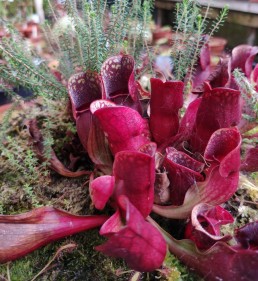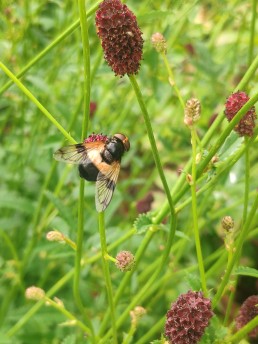Working at the gardens has been a very rewarding experience. From the start we were kept busy, a welcome change from (and partially as a result of) months of inactivity brought about by the current COVID pandemic. By the time we had arrived to work in the gardens summer was already winding down.
On fine weather days we worked outside. One of our first jobs was to start clearing the weeds which had flourished as a result of the COVID-19 lockdown when only one gardener had been on duty each day (the bindweed had had a particularly successful season!). From the start, we were given responsibility for weeding and maintaining certain areas, such as the herbaceous border by the lawn (here we are among the Agapanthus), and the fern bed in the West Arboretum. We also applied a deep layer of mulch to the fern bed, as this is still being planted up and weeds establish quickly in the gaps between plants. As well as other daily assigned tasks, we kept a close eye on these areas over the six weeks we were there.


On wet autumnal days, we remained in the warmth and relative dryness of the glasshouses. Because of the very warm sunny weather at the start of this summer, the glasshouse pest population had also flourished. In the Cycad House, some of the cycads had succumbed to a combination of mealybug and scale infestation and were in need of care and attention.
We spent some time in the Irish House too. Unlike the other glasshouses, the Irish house is quite cold as it is in shade most of the day. This house contains native and naturalised species from woodland, grassland, coastal cliffs, bogs and turlough habitats around Ireland. We spent some time here cleaning out the thatch from pots containing native grasses, rushes, sedges and horse tail ferns. While it was nice to be working around native Irish plants, we tended to spend less time here as it was quite cold, even in August!
The two resident cats, Cheeky and Fluffy, often kept us company despite their initial nervousness. As well as the cats, the gardens have a large population of well-fed squirrels. These squirrels seem particularly comfortable in the presence of humans, and on more than one occasion were caught in the act of stealing the cats’ food from inside the potting shed.

Mealybugs and scale insects are both types of herbivorous sap-sucking insects and reside mostly on the undersides of leaves. The sap they feed on is rich in sugars and the excess sap they consume is secreted as a sticky substance called ‘honeydew’ onto the leaves below: this which provides the perfect environment for the sooty mould to grow on. This also needed cleaning off as it can grow quite thick, preventing the leaf from absorbing sunlight and photosynthesising. We used some warm soapy water to carefully sponge this off and this passed quite a lot of time on a rainy day.

We also spent some time in the Long House. This contains a large and varied collection of plants, including ferns, cacti, potted trees and a large collection of carnivorous plants. An interesting group of these is the Droseraceae family, which contains perhaps the most well known of the carnivorous plant groups – the Venus flytrap, or Dionaea muscipula. The leaves of Dionaea are modified to form a trap with highly touch-sensitive leaf hairs which trigger the trap to shut tight when an unsuspecting insect lands on them. Three species from the Droseraceae family grow in Ireland: Drosera rotundifolia, Drosera longifolia and Drosera intermedia and all three are growing in the garden’s collection. The leaves of these particular plants have tentacles (glandular hairs) with a sticky gluey substance which traps and digests the unfortunate insects. This is how they get most of their nutrients, as they grow on very thin and nutrient poor soils.



Another rainy-day activity was digitising the garden’s woody plants database. We transcribed an old woody species list from an original document to an Excel spreadsheet. We cross- referenced each species with the Plants of the World Online website run by Kew Botanic Gardens. This is a very large online database containing information on the world’s flowering plants and a very useful tool containing lots of interesting information on taxonomy (how plants are classified) and distribution for over one million plants. Due to advances in phylogenetic (evolutionary relationships) research it was interesting to see how many of the plant names have changed because they have been moved into different families, genera or species. It was also really interesting to see where the plants originated, have spread to and also how some of them grown at the gardens survive in the Irish climate. One good example is the Canary Island date palm, Phoenix canariensis, which is thriving in the West Arboretum having been planted out in summer 2019.

Throughout the time that we were in the gardens we planted and potted on several plants. We repotted a number of young Paulownia tomentosa that were in desperate need of larger pots. These had been grown from seed by Botany students during a practical class at the gardens. We also dug up peony, echium, hazel and pittosporum seedlings which we potted up. All were relatively happy except the echiums. We have come to realise that echiums detest having their roots disturbed, especially if they are too established – the first batch keeled over and died within a couple of hours, despite our best attempts to leave the roots undisturbed. However, we did have success with the smallest seedlings on our second attempt. We have also both taken home a number of interesting cuttings and some very nice cooking apples!
…Bea and Conor
Some more of our favourite images from the garden…






